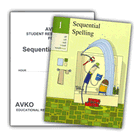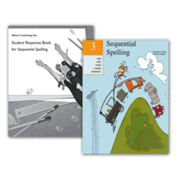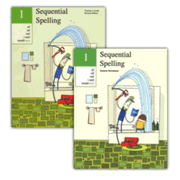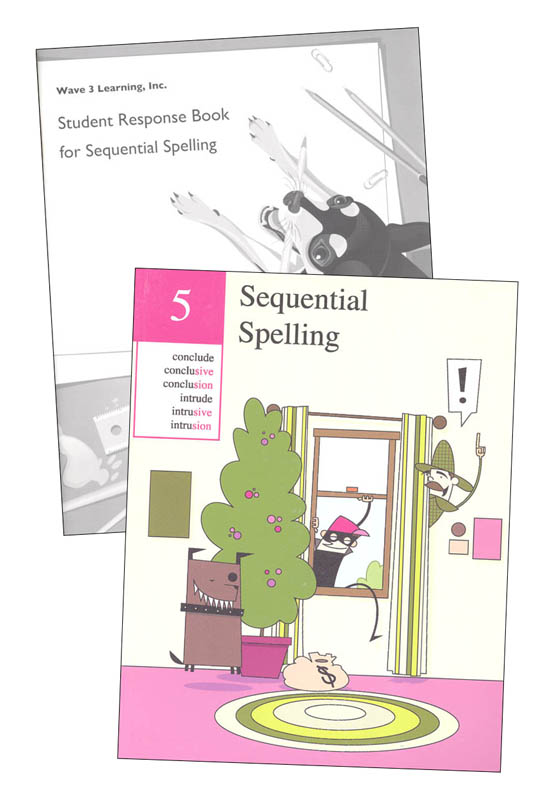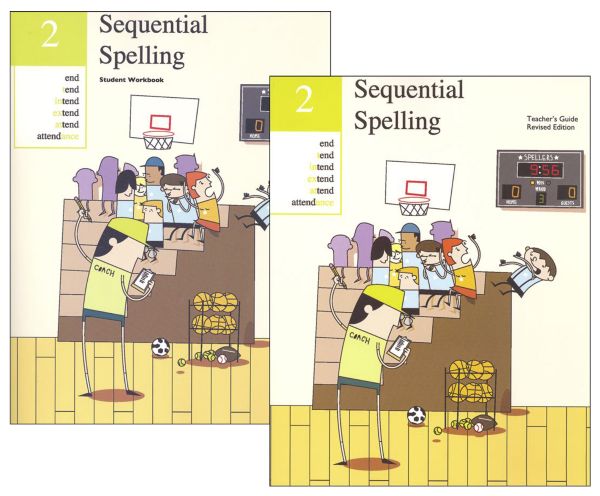Sequential Spelling is a uniquely constructed spelling system that was originally created to help dyslexic students and others with learning difficulties. However, the program has also proved useful with other students as well.
The program incorporates four key features that reflect Sequential Spelling's unusual methodology:
- Words are taught in relationship to one another, both horizontally and vertically
- Children can figure out the rules for themselves from their relationships and commonalities, but spelling rules are not taught
- Students begin by "testing" themselves by trying to write words correctly before they study them
- Words for each grade level are selected for common elements rather than grade level appropriateness
Some of these features might sound strange to you, and rightly so. Let's take these features one by one. Word relationships is not a new idea on which to construct a spelling program, but Sequential Spelling's implementation is unique in working with words both horizontally and vertically. What that means is that lessons build from common elements in two directions. For example, the first common element in level 1 is "in." Three different beginnings are connected to in to create "pin, sin," and "spin." That is the vertical development. Horizontal development combines with vertical development on the second day. The list for day 2 expands yesterday's list to "pins, sins, spins" for horizontal development. In addition, "kin, skin, win," and "twin" add vertical development. Horizontal development continues through words such as "pinned, pinning, skins," and "skinned." Although the first lesson is short, by the ninth day, there are 25 words per day.
Although these words are related by phonograms or common elements (e.g., doubling the ending consonant and adding "ed"), it is left for the student to make his or her own connections and formulate rules inductively if they so choose. (That makes this program a good choice for children who hate learning rules, but a poor choice for those who want explanations for why things work they way they do.) Of course, there is nothing to prevent the parent/teacher from presenting rules anyway if it seems appropriate.
Students begin each lesson by "testing" themselves, but this is not a pretest as in some other spelling programs. This is the actual instruction. The parent/teacher says a word, says it in a sentence, then repeats the word. Children are to try to write the word the best they can in the student workbook or in their own notebooks. Even if they only know a few letters that might be in the word, they write those down. After they've taken their best guess, the teacher writes the word. The author suggests using colored felt pens on a whiteboard. Use one color for the basic sound such as "in." Use another color for the beginning letter/s such as "p" or "sp."
Before going on to the next word, children erase and correct their word as needed. The idea is that they process their mistakes and the necessary correction. They think about the construction of words in a way that is missing in most other spelling programs. This will be helpful for some children and frustrating for others.
As they continue to build horizontally and vertically, children are quickly spelling words that would be considered well beyond their grade level. For example, by the fifth day, they are spelling "beginning." The last lesson of level 1 has no "easy" words; among the 15 words are "spying, multiplying, dissatisfying, falsifying, denying, lullabies, couldn't, wouldn't" and "schools." (Try that list with most fifth graders!)
The program is quite comprehensive. It includes spelling "demons," homophones (e.g., "air, heir"), homographs (e.g., "bat"), heteronyms (e.g., "lead"), prefixes/roots/suffixes (e.g., psy, hypo, graphic), and what the author calls "advanced patter" words such as "techniques, chauvinism," and "hors d'oeuvres." (As I typed this I realized I have yet to master the spelling of that last one!)
Sequential Spelling has seven levels that might correspond to grades 2 through 8, but the levels are definitelty not intended to indicate grade levels. The program does increase in difficulty from level to level, so it makes sense to start students of any age at level 1, then work through the levels at whatever speed suits them. Even at the lowest levels, the program never seems childish. Personally, I would wait until students are about third or fourth grade then begin them at level 1. I would also use this program with high school students (and even adults) who have never learned to spell well. The publisher suggests that teens consider using the adult level course Sequential Spelling for Adults.
Levels 1 through 3 of Sequential Spelling are available in two formats: the printed book format (in the newest "revised" editions with both a teacher edition and a student workbook) OR the iPad app version. Levels 4 through 7 will eventually be available in the iPad app format as well.
With the iPad app, a voice pronounces the words and uses them in sentences as a parent or teacher would do. Students type in the word. If a student misspells a word, the word is displayed correctly on the screen and the student types it in correctly. Students cannot proceed until the word is typed correctly. Students work with the iPad app alone. Since students have to type in their responses, they lose the kinesthetic practice of actually writing the words. The writing component might be important enough for some students to make the print versions the better choice.
The program is taught from each level's teacher edition or by the iPad app. The app allows the student to work independently while print books are a more teacher-intensive option. Either way, students are working in visual, auditory, and kinesthetic modes as they hear, see, and write (or type).
The student workbook pages for writing words have three columns per page, and they are numbered such that children are never writing their lists on the same page two days in a row—this prevents comparison or copying of word elements from the previous day. Thus, the first day's list is on page 3, the second day's list on page 5, the third day's list on page 7. Student workbooks in the revised editions also have activity pages to provide children with additional practice working with their words. Activities might be unscrambling letters to form words, writing definitions, and similar exercises. The activities are supplemental to the primary work in each lesson, so you can come up with your own system for student to write their words in a spiral notebook or with loose binder paper if you want to save money. However, you DO want to keep all of these pages together for comparison later on.
While Sequential Spelling does need to be presented by the parent/teacher if you use the print editions, it does not require preparation time. If you follow my suggestion and wait until at least third or fourth grade to begin the series, I doubt that lessons will take more than 15 to 20 minutes a day.
I suspect that Sequential Spelling will work best for students who are not detail or rule-oriented. The author breezily dismisses concerns about questions students might have about things like "s" sounding like "z" at the end of "pins." This sort of thing matters to some students and not at all to others. It seems to me that many parents whose children struggle with spelling really love the program. While that does not mean the program is only for struggling learners, it might offer a better chance of success in those situations.

